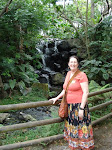

Interesting Facts:
Female Tarantula molts and eats her own skin. She does not eat her mate.
More tree species in the Cloud Forest than in the US and Canada combined
69 types of avocados can be found in the Cloud Forest
Male Quetzals are more beautiful than female Quetzals. They use their beautiful colors to attract the females.
There is a plant called HOT LIPS now nicknamed Angelina Jolie :-D
On Saturday we woke up early to go to the reserve in hopes of sighting the beautiful Quetzal bird during our nature walk. The group split up in two: half went with JC, and the other half went with Adrino.
The main objective was to explore the biodiversity and learn more about the nature that surrounds us. We ended up learning much more than we bargained for and gained a greater appreciation for the Tican culture as well. Costa Ricans have many superstitions. Both guides carried a handful of seeds in their pockets to ward away snakes. Also, at the beginning of each year to give good luck to their friends they present their friends with a purple flower.
One group had the unpleasant experience of tasting Heart of Palm. The vegetable causes extreme hunger after consumption. Those who ate it felt a hollowness in their stomach for the duration of the hike.
As we entered the Primary forest section of the reserve we approached a Hollow Fig Tree. The fig tree had grown on top of another tree and strangled the other tree species. The dead tree began to decompose and left the Fig tree hollow.








